As a participant in various guitar and bass shows over the last two decades, both as an exhibitor and visitor, I can say the Holy Grail Guitar Show in Berlin is among the best organized ... by far. Intended for the guitar nerd, it’s calmer, more accessible, and arguably the most focused and interesting expo on the European side of the Atlantic. Aiming to be the perfect experience for the discerning 6-string enthusiast, this new guitar event kicked off its first edition in Berlin, Germany, in November 2014.
Over the course of a year, there are only a few opportunities for us string lovers to learn about new developments and get the latest scoop on instrument design. Typically these are the two NAMM shows and the Frankfurt Musikmesse. These sprawling expos have it all, from parts to effects and amps, as well as huge exhibits from the biggest instrument and audio companies.
But a group of European luthiers who focus on handmade, exclusive instruments didn’t find the atmosphere of traditional musical instrument expos to be ideal, so they came together to present themselves in a different way. They began by forming the EGB—the European Guitar Builders association—as the organizing entity, and then carefully built the event around the instruments and the luthiers’ personalities.
In Europe, we would call the basic concept partially “socialistic,” knowing full well that this term is used differently in other parts of the world. For the EGB, what it means is: One equally sized table for each luthier, no big booths or advertising, and no amps within the main exhibition halls. This makes for a quieter place to display the instruments, and it allows potential customers to have direct contact with builders.
Lay of the Land
The show took place in Berlin’s Estrel Hotel, Germany’s biggest hotel and convention center. The Estrel offers two exhibition halls and several smaller rooms for lectures and demo concerts, as well as two separate rooms with sound cabins for playing electric and acoustic guitars and basses.
An astonishing number of exhibitors from all over the world came to this first round of the event. Among the 115 companies were some well-known names, along with many that were new to even an insider like myself. I met luthiers from Scandinavia and Eastern European countries, but also from the U.S., Canada, and Japan.
The festivities kicked off with a pre-event symposium and meeting for all the exhibitors a day before the show went public. Canada-based William “Grit” Laskin gave some insight into his life in lutherie and the art of his uniquely detailed inlay technique. Afterwards, the head organizers explained how the now-defunct Montreal Guitar Show inspired them, and how this show is now the only international one of its type focusing on both the builders and buyers of exclusive, handmade instruments. At this point, nobody knew what the turnout would be, which created a mix of tension, pride, and excitement that could be felt everywhere—especially among those who’d put so much sweat into making the Holy Grail Guitar Show a reality.
But the next day’s opening made it clear why this show represents an important milestone in the relationship between builders and their customers. The halls, lectures, and sound cabins were filled with a bustling crowd, and the vibe—consisting of relaxed, one-on-one meetings and exchanges among small groups of guitar enthusiasts—was remarkably different from the large, more industrial shows.
Of course, there were a lot of spectacular woods and finishes to ogle, but also an eclectic mix of concepts: In addition to the traditional master builds, you’d see headless, fanned-fret acoustics, extended-range guitars, resonators, and guitars with carbon—even leather—tops.
Music demos and lectures accompanied the two-day show. While the 20- to 30-minute demos featured instruments from a specific exhibitor, the lectures offered insights into the philosophy of building and the future of the handmade guitar business. There were a total of eight lectures on such topics as the inspirational influence of research, the thermal treatment of wood, and the use of non-tropical woods. The 25 demos all featured instruments from participating luthiers.
Alas, it’s impossible to cover everything that was exhibited, but the following descriptions and photos will give you a sense of the amazing instruments on display at the show. And you’ll find more amazing photos and information about other exhibitors on the Holy Grail website.
Fred Pons: Kopo Guitars
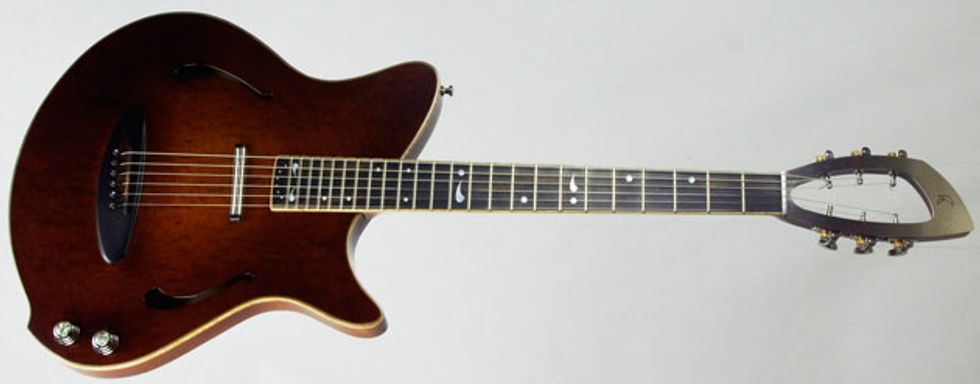
The Kopo Manhattan model.
Based in France, luthier Fred Pons started as a violin builder and now has 27 years of experience crafting stringed instruments. His guitars often incorporate a nickel-anodized brass headplate. In fact, one of his specialties is to combine various materials from metal to carbon reinforcements. The Manhattan’s dual-pickup system features Fishman saddle piezos combined with a sliding Benedetti double-coil magnetic pickup. You slide the pickup by moving a magnet in an opening at the back of the body.
Sophie Dockx: Dorian Guitars
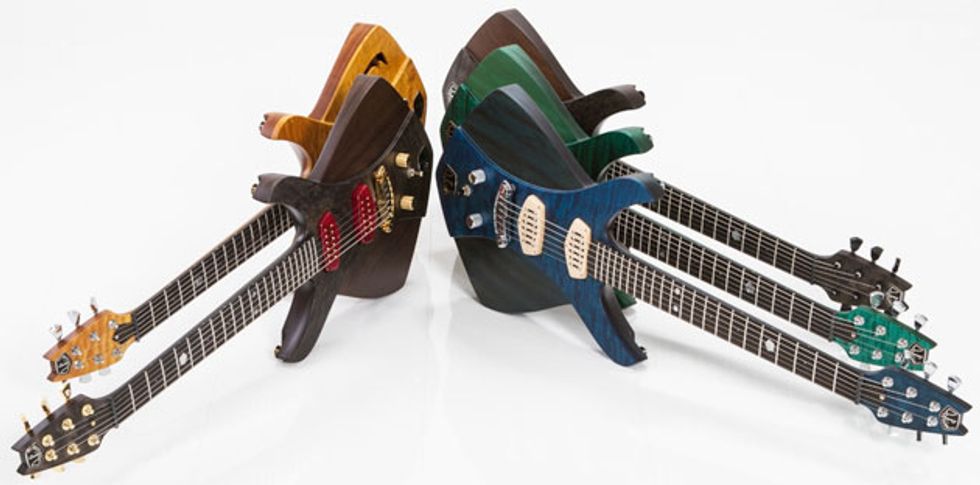
Belgian luthier Sophie Dockx designed and built her first guitar in 1979 at age 17. She worked as a performing artist and guitar teacher for 30 years, while also supporting herself as an industrial designer for IBM. In 2004 she formed Dorian Guitars, where she now sticks to design and prototyping, as her guitars are built by Sander de Gier in the Netherlands.
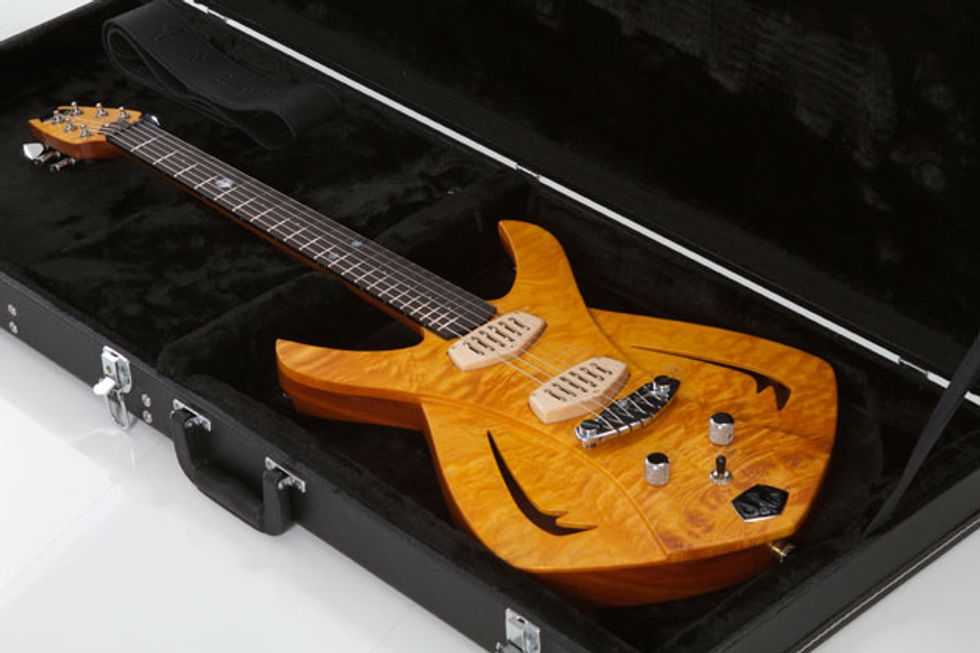
The Dorian family consists of a line of electric and acoustic instruments that can be played by either right- or left-handed musicians. The LRQC-1 bridge can be flipped over to convert the intonation to left-handed stringing. The symmetrical body shape provides an optimal playing position in either orientation. The positioning of the controls is rather unorthodox—behind the bridge and out of the way of the strumming action, but still very close at hand. The wiring of the two controls can be easily converted from right- to left-hand action.
The Dorian line includes the Rondo, a neck-through solidbody electric made from mahogany with a maple top and ebony fretboard. Developed by Harry Häussel, the pickup is a narrow-window humbucker with an expanded distance between the coils to reduce crosstalk. The Django model is an acoustic-electric guitar in one. It sports a magnetic pickup and allows for high-definition acoustic tones at less than 100 pounds of string tension. It’s designed to sound somewhere between a steel-string acoustic and an archtop, while keeping the playability of an electric.
Kora Jünger and Frank Deimel: Deimel Guitarworks

Deimel Firestar Special Artist Berlin model.
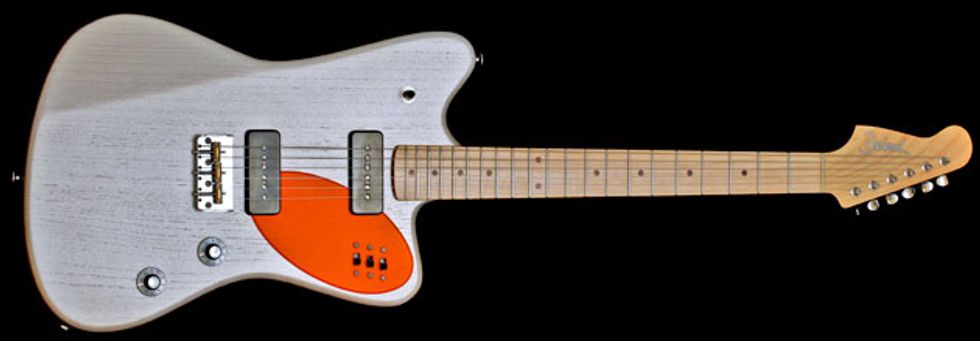
Deimel Firestar model.
Here’s where things get wild: Via a toggle switch, the guitar’s Deimel JM and J pickups are routed either through a standard volume and tone circuit, or through an active stereo circuit that automatically pans between the bridge and neck pickups. Deimel calls this circuit the Pickup LesLee; once it’s activated, the player can control the panning speed using a dedicated onboard knob. The speed can be very slow, very fast, or anything in between. Because the circuit is stereo, it’s possible to route the signal through two amps or send it to two mixer channels with different signal chains onstage or in the studio.
Michael Spalt: Spalt Guitars
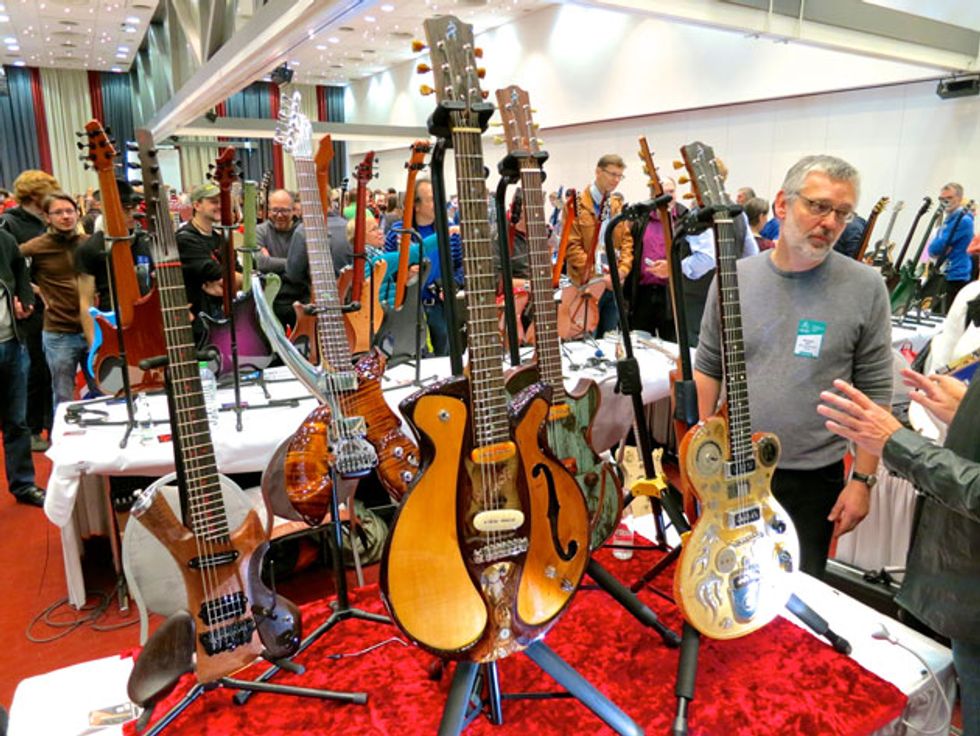
Michael Spalt talks to a visitor at his Holy Grail Guitar booth.
Uwe Schölch: Tonfuchs
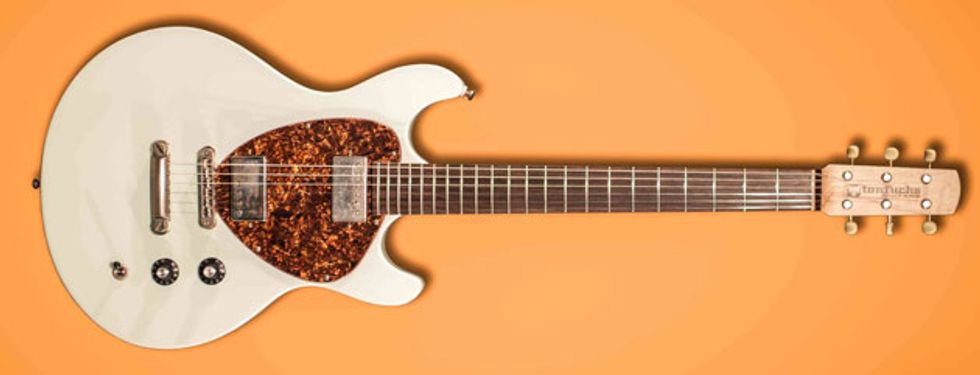
Tonfuchs Booty model
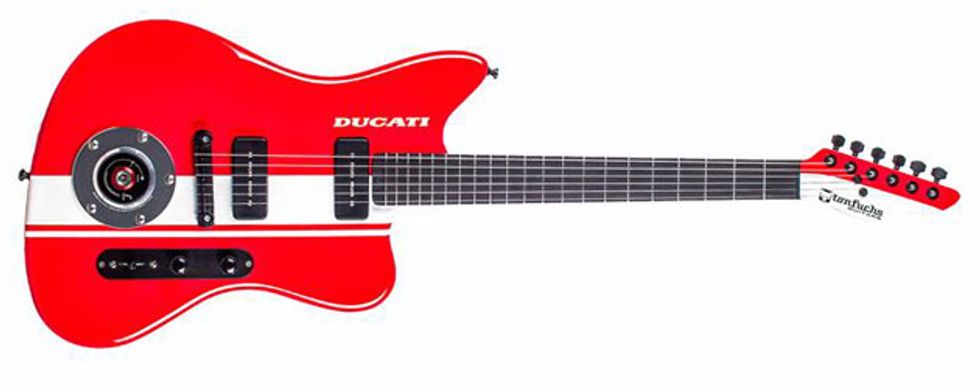
Tonfuchs Bulldog Ducati.
Serge Michiels and John Joveniaux: TAO Guitars
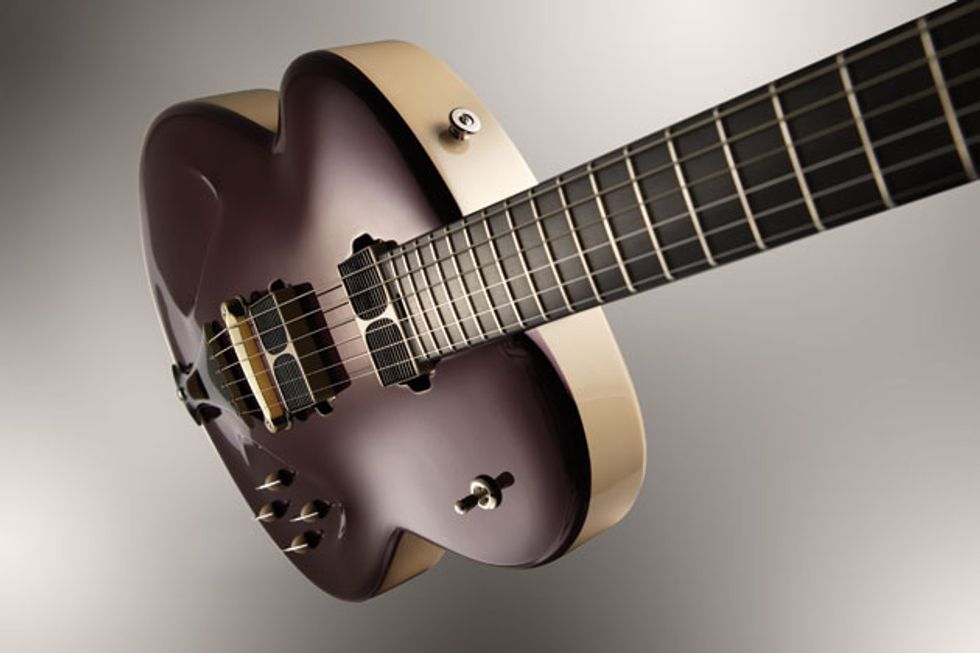
The first Phaeton model by TAO Guitars was inspired by both a Gibson Style 03 and classic American automobiles from the 1930s and ’40s.
Premier Guitar featured TAO Guitars in the October 2013 issue’s Modern Builder Vault. The company is run by Belgian duo Serge Michiels and John Joveniaux, who transitioned from guitar repairmen to luthiers eight years ago by focusing on instruments done the old way. Though they started with repros of Strats, Teles, and Les Pauls, they now have their own style—one that’s heavily influenced by auto designs.
A hollowbody made from spruce and mahogany, the Phaeton sports soundholes that are reminiscent of the golden age of American cars. Another specialty on all their guitars is the fretwork. TAO guitars have a medium-jumbo fretwire up to the 12th fret. Then in the second octave, the frets switch to a smaller size to allow more room to finger phrases in the higher registers.
Claudia and Claudio Pagelli: Pagelli Guitars
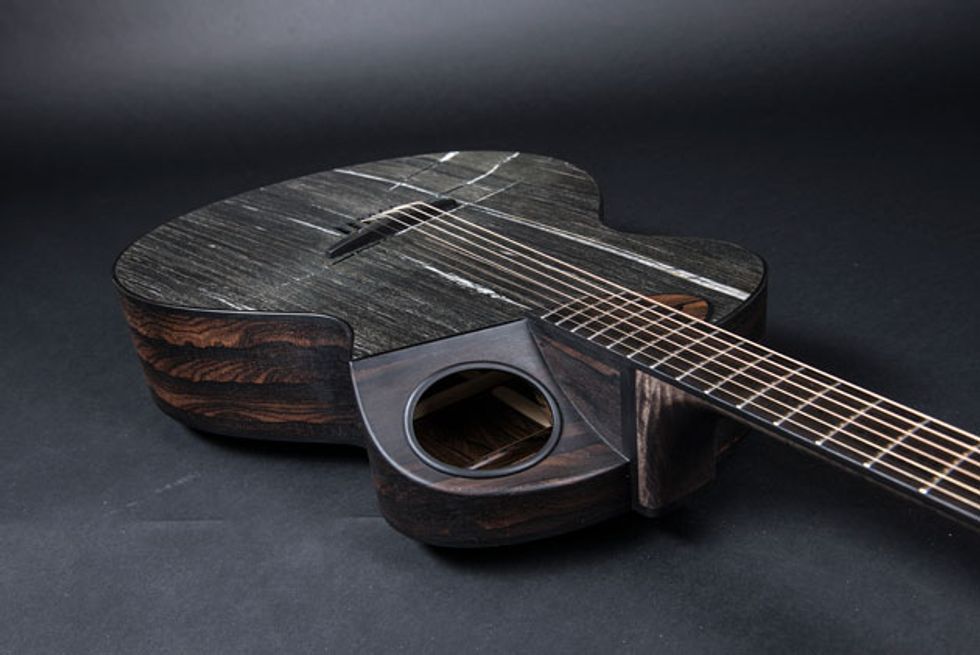
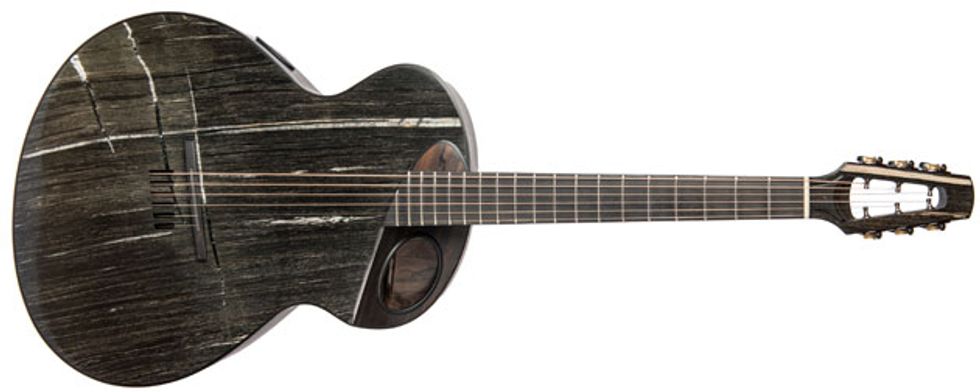
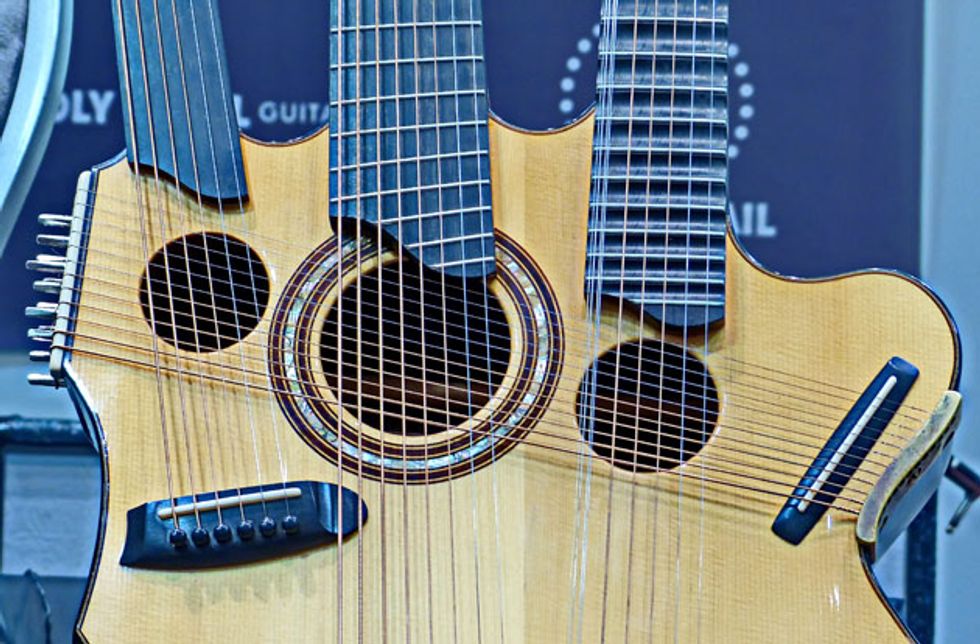
More from the Floor
From Linda Manzer’s stunning acoustic triple-neck harp guitars (the unofficial winner of most strings on one guitar), to Grit Laskin’s artisan inlays, to the many other stunning and varied designs beckoning from every corner, there was simply too much at the Holy Grail Guitar Show to provide an in-depth report on everything. That said, here are a few more noteworthy tidbits from Berlin’s inaugural guitar show:• Though SKC is known for their composite basses, luthier Stefan Hess surprised attendees with the company’s first guitar.
• Ville Tyyster, of Finland’s Tyyster Guitars, showed his fully hollow, steel-bodied 6-strings.
• Also from Finland, Juha Ruokangas presented the Captain Nemo hollowbody, which looks back to timeless designs with its meld of classical guitar and violin body shapes. It also includes the Valvebucker, a magnetic pickup conjoined with an internal tube amp.
• Akiko Oda and Kaz Goto, of Jersey Girl Homemade Guitars, showed their doubleneck guitar and bass composed of colored woods that were artfully arranged in a typically Japanese style.
• Chris Larsen displayed unique metal-bodied guitars that reflect his vision of an ideal guitar for armed troops in service. The design includes an internal speaker, a small headstock, and a one-bolt neck joint that lets you easily fold and transport the axe. And there’s more: An iPhone bay allows you to run his guitars through amp simulator apps.













![Rig Rundown: Russian Circles’ Mike Sullivan [2025]](https://www.premierguitar.com/media-library/youtube.jpg?id=62303631&width=1245&height=700&quality=70&coordinates=0%2C0%2C0%2C0)













